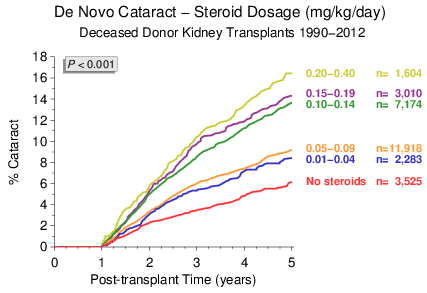Newsletter 1:2015
February 01, 2015
As always at the start of the year, the outcome graphs on the CTS website
(www.ctstransplant.org) have been updated by one year to keep them as current as possible.
In addition, your own center-specific graphs have been updated with each quarterly cycle so
that the most recently reported follow-up data are included with minimal delay. The analysis
of your own center´s data, of course, can only be as good as the data you provide. Complaints
about inadequate center statistics on the CTS website are commonly traced to incomplete
documentation. Please document as completely as possible, in your own interest and to help
maintain the high quality of the CTS registry.
In previous issues of this newsletter, as well as in published articles, we have frequently
described the deleterious impact of steroid treatment on long-term transplant outcomes (CTS
Newsletters 1:1999, 4:2000, 3:2013, Am J Transplant 5: 720-728, 2005). We would like to
extend this by now presenting data on the occurrence of post-transplant de novo cataracts in
relation to the maintenance steroid dose. As shown in Figure 1, the incidence of de novo
cataracts to year 5 post-transplant shows a striking correlation with the daily dosage of
steroids at year 1. We have previously pointed out that although some patients may require
high-dose treatment, the CTS data suggest that many transplant patients receive unnecessarily
high dosages of steroids for maintenance immunosuppression (Am J Transplant 13:2096-
2105, 2013). While cataracts are not life-threatening, they clearly represent an undesirable
condition which, according to the CTS data, would be avoidable in many patients by reducing
their exposure to steroids.

Figure 1
I would like to finish this newsletter on a personal note. I have been privileged to
collaborate with you in the CTS for more than 30 years. These years have been an
experience that has formed not only my career but my life. I cannot even begin to
count the many occasions on which I have been gratified and humbled by the generosity
and support that so many of you have extended to me.
I have now reached the end of my academic career and it is therefore time for me to
draw my role in the CTS to a close. Caner Süsal, my colleague for more than 20 years,
will be in charge of coordinating the CTS activities from now on. I am confident that he,
with the support of the experienced CTS staff, will continue in the spirit of collaboration
that has been the hallmark of CTS for the last 30 years. I will still be available for
assistance and advice as needed.
I am indebted to all of you, most of whom I have known personally and treasured as
colleagues and friends, who have taught me so many things about transplantation,
and who have made CTS the valuable information source that it is today. I wish you all
the very best, and I wish the field of transplantation and the Collaborative Transplant
Study continued success.
With my sincere personal gratitude,
Gerhard Opelz

